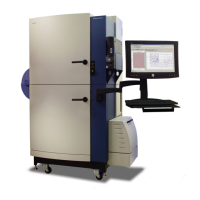Robotic Integration
222 0112-0109 H
Instrument Overview
Instrument Basic Function
FLIPR
®
Tetra System is a fluorescence microplate reader used primarily
for kinetic live cell-based fluorescence and luminescence assays. A
typical assay involves the following steps:
• Introduction of a read plate containing cells in solution or
compounds into the instrument.
• Acquisition of a baseline read (or series of reads) to determine
the background fluorescence or luminescence signal from the
read plate.
• Introduction of a potentially activating (or potentially
inactivating) compound into the well or cells in suspension.
• Monitoring the changes in the fluorescence or luminescence
signal from the read plate for a period of time immediately
following the introduction of the compound.
• Further additions of different compounds to the well are typical
in an assay on a FLIPR
®
Tetra System. Between additions, the
pipette tips used for fluid transfer may be replaced or washed.
Cell response in a typical assay typically begins within 2 seconds of fluid
addition and is monitored for 1–3 minutes. Fluorescence or
luminescence signals are monitored at wavelengths and frequencies
selected by the user within the physical constraints of the instrument.
Instrument Hardware Introduction
To accomplish the assays described, the instrument includes the
following subsystems:
• Embedded control system: The instrument contains an
embedded control system for use in controlling the instrument.
This control system may be accessed only by the instrument
applications software—ScreenWorks—which is supplied with the
instrument.
• Plate reader: The optics subsystem includes an illumination
source with excitation filters, emissions filters in a three-position
filter changer, and a CCD camera. This system is used to read
both fluorescence and luminescence assays.
• Pipettor: In order to accomplish kinetic assays, the instrument
contains a pipettor which can add fluids to the read plate during
a series of reads. The pipettor, equipped with a 96-, 384-, or
1536-well head, can be used for general purpose fluid transfer
between any of the plates in the instrument. Each head type
uses pipette tips, or a pin tools. For 96- and 384-well pipettor
heads, this is a disposable plastic pipette tip. For 1536 this is a

